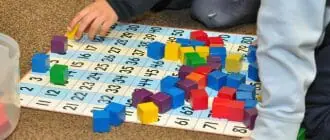Flexible seating has long been considered a good way to motivate students to focus on lessons and engage in the classroom, but adding stability balls to the mix is relatively new. According to Dr. John Rately from Harvard University, the tiny movements children need to make to stay balanced on a stability ball stimulate their brains and help them focus. There isn’t much research on the subject, but I have found enough to convince me.

Stability balls are also known as exercise balls and are mainly used in athletic training, physical therapy and exercise classes. Made from anti-burst PVC plastic, they are designed for pliability and safety. They are resilient and designed to be just bouncy enough. The balls generally have a 14 – 33-inch radius. They have a valve system that allows you to control the air pressure, so it can be soft or firm according to the activity and user’s preference.
According to a study on stability balls in a first-grade classroom that was published in The Journal of Teacher Action Research at Abilene Christian University, student attentiveness in class was related to movement and productivity. The study also showed that the students valued the chance to choose their seating.

I have done a lot of research on the subject of flexible seating in the elementary school classroom, which you can read about here. Some students found movement to be distracting. One way to allow all students to choose their seating, so some can avoid movement is to include bean-bag chairs and area rugs with cushions.
How to Use Stability Balls for the Elementary Classroom
There are several types of stability balls suitable for exercise and physical therapy. For my classroom, I choose balls that are about 22-inches radius. For most elementary-aged children this is the right size. They should be able to sit on the ball with their legs at a 90-degree angle. Slightly more is all right but not less.
Another guideline is not to blow the ball up to its full capacity. When the person sits on the ball, it should give enough to create a little seat. This helps provide stability and allows the child to sit evenly on the ball. For a classroom, the ball is not intended for exercising. Just sitting on a stability ball can be challenging because the ball is an unstable environment that causes core muscles to contract to keep you from falling off.
The Benefit of Stability Balls in the Classroom
Sitting still for hours on end isn’t the best way for children to develop. According to Diana A. Henry in Staying in Touch, an award-winning occupational therapist and author of the Sensory Processing Measure Quick Tips, children are continuously moving or wiggling, some more than others. Their sensory system is not developed enough to support sitting still for long periods. That’s why they need recess to help develop their central nervous system and brain as well as their bodies, according to Henry.
Ball chairs help channel children’s physical energy in a positive way, so they can apply more mental focus and interest in the lesson. How does this happen? Rately explains that subconscious mental activity is at the core of the reason the ball helps students focus. The tiny adjustments the child makes to balance on the ball stimulates their brain and helps them focus.
Rately adds that this is also true for children with attention disorders. They have a dulled cortex and even the small exercise of sitting on a stability ball combats that mental disengagement. By using their core muscles for balancing, they turn on their cortex which helps them in several ways including inhibiting impulses.
Studies on Learning Disorders and Stability Balls
One study by Schilling & Schwartz in 2003 was the first to examine the use of stability balls and their effect on in-seat behavior and legible word productivity in a fourth-grade classroom. The whole class of 24 students was given stability balls, but only the three students that had been diagnosed with ADHD were observed. Each student was given language arts assignments and the results were scored by independent raters for legibility. The study took 12 weeks, and at the end it showed that legible word productivity improved while students were sitting on stability balls compared to when they were sitting on classroom chairs.

More recent studies question whether stability balls work for all of the school population or just a few. In 2019, a study was conducted with second-grade students to determine the on-task behavior and academic outcomes of students using stability balls instead of hard chairs. Conducted by Julie Elizabeth Mercer, Doctor of Education at the University of Findlay, the study showed that while the in-seat focus on tasks improved for most of the students using the balls, the academic outcome was not much improved. Interestingly, almost all the students and teachers liked using the balls and planned to continue doing so.
What are the Effects of Stability Balls?
According to a study conducted at the Minnesota State University in 2015, in the past, the research on using stability balls in an elementary classroom was focused on behavioral observation, self-report measures and legible handwriting.

More recent studies focused more on increased on-task behavior, improvement of academic productivity and decrease of out-of-seat behavior.
Behavioral assessment was measured by direct observation. This is usually done by observers trained in what to look at during specific times. Direct observation and is considered the most effective because it produces the least inference.
Academic productivity is mainly studied through legible handwriting. The results were positive but legible handwriting is only part of the academic area of written expression. A curriculum-based measurement that was designed 25 years ago was applied to the use of stability balls. It requires sustained mental effort and not just writing words on paper. The study of a second-grade class included:
- Participants and setting
- Materials
- Measurement and response definition
- Training for collecting data
- Design of the study
- Procedures
- Baseline
- Stability balls
- Data analysis
- Integrity and reliability
- Social validity
The results showed that stability balls produced about the same on-task behavior as chairs with a slight reduction. For out-of-seat behavior, there was an increase with stability balls than with chairs. For academic productivity, there was an increase in writing fluency, but for the overall academic productivity, the chairs and stability balls were about the same.

The reason I tried stability balls as flexible seating in my classroom is because of the research done at the University of Findlay’s College of Education in 2019 which quotes several studies and presents the results of a standardized math test. Students who used stability balls as chairs showed a larger amount of growth than students in classrooms that had a 10-minute activity break and a classroom with no break. One possible reason for this was expressed by a student who said the stability ball forced him to stay awake and pay attention. There was also an increase in on-task focus of the children sitting on stability balls compared to the children sitting in chairs.
The results of a study at Grand Valley State University by John Kilbourne, of college-aged students sitting on stability balls are almost completely positive for:
- Greater balance because the body must constantly change its center of gravity to stay seated
- Core strength training because of that constant change the neck, middle and upper back and shoulder girdle, gluteal, abdominals and leg muscles make constant adjustments
- Improved posture and body alignment because the body naturally assumes a straight, upright position

The study also included the feedback of the students. The mean response on the questionnaire with one being negative and five being positive was higher than four. The categories were:
- The ability to concentrate in class
- The ability to take notes in class
- The ability to pay attention in class
- The ability to participate in classroom discussions
- The ability to take exams
- The ability to maintain an upright posture
- The ability to engage the lower body
- Would you use a stability ball as a chair in the future?
Types of Stability Balls
 I use the traditional elastic ball for my elementary school students, but you can get balls that have legs. Some have a base and metal legs with feet called ball chairs. Others have elastic finger-like projections on one side of the ball called built-in legs. They provide a bit more stability, but I find most children can hold their own on a normal ball.
I use the traditional elastic ball for my elementary school students, but you can get balls that have legs. Some have a base and metal legs with feet called ball chairs. Others have elastic finger-like projections on one side of the ball called built-in legs. They provide a bit more stability, but I find most children can hold their own on a normal ball.
You can also get stands that hold the ball as well as ball chairs with one flat side. Since stability balls are designed to be safe, they cannot be repaired if they accidentally get punctured by a pen or pet.
Bottom Line
Flexible seating is an important component of a successful classroom. You can learn a lot about how classroom rugs can help children make a choice and have fun while learning here. Giving students a choice of how and where to sit promotes self-respect and confidence.
The other flexible seating arrangement I like is beanbag chairs. They are not only comfortable, they give a child the feeling of personal space. You can see my research on the subject here.
When I learned about using stability balls as part of flexible seating, I looked for research on the subject. Stability balls have a special advantage in that they allow a child to move while sitting in one place. This is a huge benefit because the movement is the main benefit of flexible seating.
- Exercise Balls in the Classroom?
https://www.chicagotribune.com/sns-health-school-bouncy-balls-story.html - Student and Teacher Perceptions of Stability Balls as Alternative Seating in a First Grade Classroom
http://www.practicalteacherresearch.com/uploads/5/6/2/4/56249715/student_and_teacher_perceptions_of_stability_balls_as_alternative_seating_in_a_first_grade_classroom.pdf - Staying in touch
http://www.henryot.com/articles.asp - Stability Balls in the Classroom: Effects on Engagement and Achievement
https://etd.ohiolink.edu/pg_10?::NO:10:P10_ETD_SUBID:181706 - Alternative Seating for Young Children with Autism Spectrum Disorder: Effects on Classroom Behavior
https://www.researchgate.net/publication/8264845_Alternative_Seating_for_Young_Children_with_Autism_Spectrum_Disorder_Effects_on_Classroom_Behavior - Investigating Stability Balls in the Classroom: Effects on Student Behavior and Academic Productivity
https://cornerstone.lib.mnsu.edu/cgi/viewcontent.cgi?referer=&httpsredir=1&article=1395&context=etds - Sharpening the Mind Through Movement: Using Exercise Balls as Chairs in a University Class
https://www.northallegheny.org/cms/lib4/PA01001119/Centricity/Domain/272/Exercise%20Balls%20as%20Chairs%20PDF.pdf
Last Updated on July 18, 2022 by Emily
- Facebook9
- Twitter21
- Pinterest67
- 97shares




